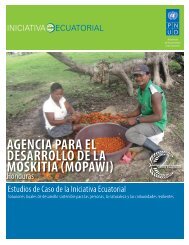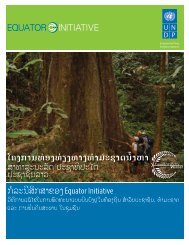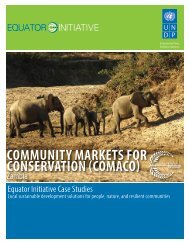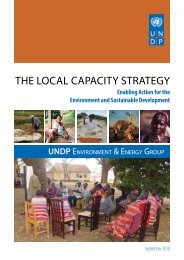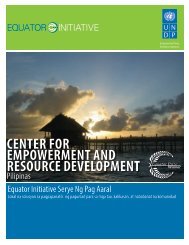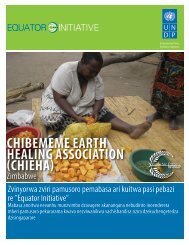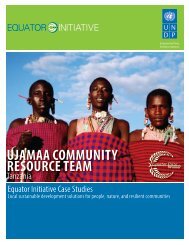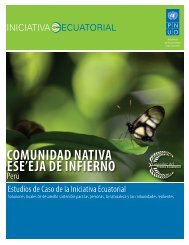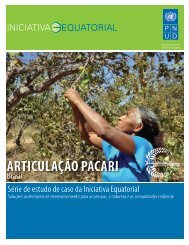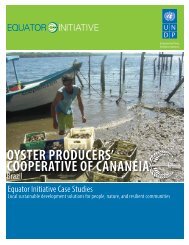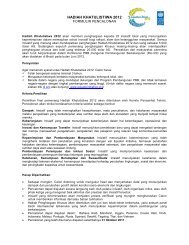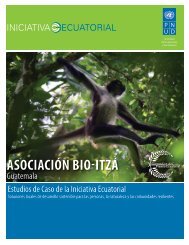INDIGENOUS TOURISM NETWORK OF MEXICO - Equator Initiative
INDIGENOUS TOURISM NETWORK OF MEXICO - Equator Initiative
INDIGENOUS TOURISM NETWORK OF MEXICO - Equator Initiative
Create successful ePaper yourself
Turn your PDF publications into a flip-book with our unique Google optimized e-Paper software.
throughout Mexico. As part of this program, communities receive<br />
funding from the national government to develop concepts and services<br />
in order to attract visitors and improve local infrastructure.<br />
Despite such examples of progress, indigenous communities are<br />
still in Mexico’s lower economic strata. This motivates RITA’s members,<br />
through their regional leadership, to increase involvement and<br />
membership in the initiative, in order to integrate the regional networks<br />
and further communities’ opportunities for advancement.<br />
POLICY IMPACTS<br />
The right of indigenous communities to make autonomous decisions<br />
regarding the management of their territories underlies all of<br />
RITA’s work. In this respect, RITA represents its indigenous members<br />
at national and international forums. In 2009, RITA representatives<br />
attended the 15th Conference of the Parties to the United Nations<br />
Framework Convention on Climate Change (COP 15) in Copenhagen<br />
to take part in the preparation of the indigenous manifesto on global<br />
biodiversity conservation, as well as attended various national and<br />
international forums on environmental issues and climate change.<br />
Similarly, RITA secured a seat at the COP16, in Cancun, Mexico in<br />
2010. RITA was the host organization of the indigenous delegates<br />
represented at COP16, and with its Latin American counterparts,<br />
worked to defend the rights of indigenous peoples regarding the<br />
environment and their right to make decisions pertaining to their<br />
territories. In addition, as part of Latin American representation of<br />
indigenous peoples, the presentation of RITA’s Coordinator on Climate<br />
Change had influence in international forums, including the<br />
2010 Mérida Declaration of the Third Mesoamerican Congress of<br />
Protected Areas.<br />
Furthermore, RITA’s members often participate as speakers at various<br />
forums and workshops on environmental issues and indigenous<br />
rights. In addition to involving members in these issues, these workshops<br />
and forums have also presented a platform for RITA to advocate<br />
for policy change regarding the attitudes towards indigenous<br />
peoples. RITA has advocated that indigenous peoples must be considered<br />
an entity capable of representing their portion of the national<br />
population. Additionally, several RITA members serve on Advisory<br />
Councils, legal bodies created by the Mexican state.<br />
RITA has achieved some success in pursuing its goals in the judicial<br />
realm. In the Tlahuica region of Mexico, agricultural judicial authorities<br />
gave a favorable verdict to RITA communities that resulted in<br />
the local indigenous community being granted control over almost<br />
24,000 hectares in the area of the Zempoala lagoons. This decision,<br />
after half a century of litigation, was achieved after RITA had contact<br />
with and contributed to the empowerment of community leaders<br />
from the town of San Juan Atzingo.<br />
RITA has also made preparations to form an Indigenous Business<br />
Chamber of Mexico, a proactive plan to integrate other sectors or<br />
branches into the organization and bring together people in similar<br />
fields, or industrial or services activities, to share best practices.<br />
This idea has been welcomed by the International Labour Organization,<br />
the National Autonomous University of Mexico and the Spanish<br />
Agency of International Cooperation and Development.<br />
In terms of influencing policy, RITA cites corruption, and government<br />
and legal initiatives that are unfavorable towards indigenous<br />
people as the greatest barriers to its success. RITA’s proposals have<br />
also frequently been rejected as being traditional and anachronistic,<br />
and their efforts have often been ignored due to a lack of formal results<br />
and organization. However, through capacity building, RITA has<br />
become more prepared and its members have begun to overcome<br />
these barriers. Now, government projects and programs are beginning<br />
to take into account the needs and practices of indigenous<br />
communities, which has resulted in a greater number of invitations<br />
to participate in policymaking.<br />
“RITA would provide three pieces of advice to other communities who wish to create<br />
an effective and sustainable project on biodiversity conservation. First, prioritize your<br />
achievements and traditional knowledge, and align local concerns with development plans<br />
that are measurable in the short and medium term. Second, you must ensure that the input of<br />
advisers and consultants is appropriate for local conditions, that interventions are focused<br />
on providing permanent employment, and not only temporary, and that regarding natural<br />
resources, you have real plans for preservation, not exploitation. Third, you must gain a clear<br />
understanding of all required administrative, legal and marketing tools, so that they do not<br />
inadvertently undermine progress. Information technology is an area of work that assists, it is<br />
not an end; it is only a means to organize and to define appropriate control in the daily work of<br />
the company.”<br />
Cecilio Solís, RITA<br />
10



